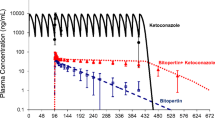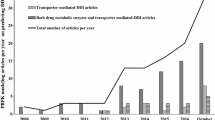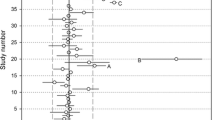Abstract
The prediction of drug–drug interactions (DDIs) plays critical roles for the estimation of DDI risk caused by inhibition of CYP3A4. The aim of this paper is to develop a physiologically based pharmacokinetic (PBPK)-DDI model for prediction of the DDI co-administrated with ketoconazole in humans and evaluate the predictive performance of the model. The pharmacokinetic and biopharmaceutical properties of 35 approved drugs, as victims, were collected for the development of a PBPK model, which were linked to the PBPK model of ketoconazole for the DDI prediction. The PBPK model of victims and ketoconazole were validated by matching actual in vivo pharmacokinetic data. The predicted results of DDI were compared with actual data to evaluate the predictive performance. The percentage of predicted ratio of AUC (AUCR), Cmax (CmaxR), and Tmax (TmaxR) was 75%, 69%, and 91%, respectively, which were within the twofold threshold (range, 0.5–2.0×) of the observed values. Only 3% of the predicted AUCRs are obviously underestimated. After integration of the reported fraction of metabolism (fm) into the PBPK-DDI model for limited four cases, the model-predicted AUCRs were improved from the twofold range of the observed AUCRs to the 90% confidence interval. The developed method could reasonably predict drug–drug interaction with a low risk of underestimation. The present accuracy of the prediction was improved compared with that of static mechanistic models. The evaluation of predictive performance increases the confidence using the model to evaluate the risk of DDIs co-administrated with ketoconazole before the in vivo DDI study.
Graphical Abstract






Similar content being viewed by others
Abbreviations
- ACAT:
-
Advanced compartmental absorption and transit
- AUCR:
-
Ratio of area under the concentration–time curve of victim after co-administration with ketoconazole over area under the concentration–time curve of victim with dosing alone
- C maxR:
-
Ratio of victim Cmax after co-administration with ketoconazole over victim Cmax with dosing alone
- F a :
-
Cumulative intestinal absorption, %
- FDA:
-
Food and Drug Administration
- f m :
-
Fraction of metabolism
- f u :
-
Fraction unbound in the plasma
- GMR:
-
Geometric mean ratio
- K 12 :
-
Transfer rate constant from central compartment to peripheral compartment
- K 13 :
-
Transfer rate constant from central compartment to peripheral compartment 2
- K 31 :
-
Transfer rate constant from peripheral compartment 2 to peripheral central compartment
- k i :
-
Inhibition constant of ketoconazole
- MPT:
-
Mean precipitation time
- PC1:
-
Peripheral compartment 1
- PC2:
-
Peripheral compartment 2
- R bp :
-
Ratio of concentration in whole blood versus plasma
- T maxR:
-
Ratio of victim Tmax after co-administration with ketoconazole over victim Tmax with dosing alone
- UDF:
-
Excretion of unchanged drugs in feces
- UDU:
-
Excretion of unchanged drugs in urine
- V c :
-
Distribution volume in central compartment
References
Dresser GK, Spence JD, Bailey DG. Pharmacokinetic-pharmacodynamic consequences and clinical relevance of cytochrome P450 3A4 inhibition. Clin Pharmacokinet. 2000;38(1):41–57. https://doi.org/10.2165/00003088-200038010-00003.
Liu L, Bello A, Dresser MJ, Heald D, Komjathy SF, O’Mara E, et al. Best practices for the use of itraconazole as a replacement for ketoconazole in drug-drug interaction studies. J Clin Pharmacol. 2016;56(2):143–51. https://doi.org/10.1002/jcph.562.
FDA. In vitro metabolism- and transporter-mediated drug–drug interaction studies guidance for industry. 2020. Available from: https://www.fda.gov/media/134582/download. Accessed 29 Aug 2021.
Ogasawara K, Xu C, Kanamaluru V, Palmisano M, Krishna G. Effects of repeated oral doses of ketoconazole on a sequential ascending single oral dose of fedratinib in healthy subjects. Cancer Chemother Pharmacol. 2020;85(5):899–906. https://doi.org/10.1007/s00280-020-04067-3.
FDA. New drug application, NOURIANZ, clinical pharmacology and biopharmaceutics reviews. 2019. Available from: https://www.accessdata.fda.gov/drugsatfda_docs/nda/2019/022075Orig1s000ClinPharmR.pdf. Accessed 15 Sep 2021.
Einolf HJ, Chen L, Fahmi OA, Gibson CR, Obach RS, Shebley M, et al. Evaluation of various static and dynamic modeling methods to predict clinical CYP3A induction using in vitro CYP3A4 mRNA induction data. Clin Pharmacol Ther. 2014;95(2):179–88. https://doi.org/10.1038/clpt.2013.170.
Ren HC, Sai Y, Chen T. Evaluation of generic methods to predict human pharmacokinetics using physiologically based pharmacokinetic model for early drug discovery of tyrosine kinase inhibitors. Eur J Drug Metab Pharmacokinet. 2019;44(1):121–32. https://doi.org/10.1007/s13318-018-0496-4.
Hsueh CH, Hsu V, Pan Y, Zhao P. Predictive performance of physiologically-based pharmacokinetic models in predicting drug-drug interactions involving enzyme modulation. Clin Pharmacokinet. 2018;57(10):1337–46. https://doi.org/10.1007/s40262-018-0635-8.
Lu AT, Frisella ME, Johnson KC. Dissolution modeling: factors affecting the dissolution rates of polydisperse powders. Pharm Res. 1993;10(9):1308–14. https://doi.org/10.1023/a:1018917729477.
Rowland M, Matin S. Kinetics of drug-drug interactions. J Pharmacokin Biopharm. 1973;1:553–67.
Brown HS, Galetin A, Hallifax D, Houston JB. Prediction of in vivo drug-drug interactions from in vitro data: factors affecting prototypic drug-drug interactions involving CYP2C9, CYP2D6 and CYP3A4. Clin Pharmacokinet. 2006;45(10):1035–50. https://doi.org/10.2165/00003088-200645100-00006.
Yamazaki S, Johnson TR, Smith BJ. Prediction of drug-drug interactions with crizotinib as the CYP3A substrate using a physiologically based pharmacokinetic model. Drug Metab Dispos. 2015;43(10):1417–29. https://doi.org/10.1124/dmd.115.064618.
de Kanter R, Sidharta PN, Delahaye S, Gnerre C, Segrestaa J, Buchmann S, et al. Physiologically-based pharmacokinetic modeling of macitentan: prediction of drug-drug interactions. Clin Pharmacokinet. 2016;55(3):369–80. https://doi.org/10.1007/s40262-015-0322-y.
Einolf HJ, Lin W, Won CS, Wang L, Gu H, Chun DY, et al. Physiologically based pharmacokinetic model predictions of panobinostat (LBH589) as a victim and perpetrator of drug-drug interactions. Drug Metab Dispos. 2017;45(12):1304–16. https://doi.org/10.1124/dmd.117.076851.
Simulations Plus, Inc., 2018. GastroPlus manual (version 9.6.0001). Lancaster, CA, USA.
Rytkonen J, Ranta VP, Kokki M, Kokki H, Hautajarvi H, Rinne V, et al. Physiologically based pharmacokinetic modelling of oxycodone drug-drug interactions. Biopharm Drug Dispos. 2020;41(1–2):72–88. https://doi.org/10.1002/bdd.2215.
Guo Y, Lucksiri A, Dickinson GL, Vuppalanchi RK, Hilligoss JK, Hall SD. Quantitative prediction of CYP3A4- and CYP3A5-mediated drug interactions. Clin Pharmacol Ther. 2019. https://doi.org/10.1002/cpt.1596.
Ono C, Hsyu PH, Abbas R, Loi CM, Yamazaki S. Application of physiologically based pharmacokinetic modeling to the understanding of bosutinib pharmacokinetics: prediction of drug-drug and drug-disease interactions. Drug Metab Dispos. 2017;45(4):390–8. https://doi.org/10.1124/dmd.116.074450.
Einolf HJ, Zhou J, Won C, Wang L, Rebello S. A Physiologically-based pharmacokinetic modeling approach to predict drug-drug interactions of sonidegib (LDE225) with perpetrators of CYP3A in cancer patients. Drug Metab Dispos. 2017;45(4):361–74. https://doi.org/10.1124/dmd.116.073585.
Freise KJ, Shebley M, Salem AH. Quantitative prediction of the effect of CYP3A inhibitors and inducers on venetoclax pharmacokinetics using a physiologically based pharmacokinetic model. J Clin Pharmacol. 2017;57(6):796–804. https://doi.org/10.1002/jcph.858.
Umehara K, Huth F, Jin Y, Schiller H, Aslanis V, Heimbach T, et al. Drug-drug interaction (DDI) assessments of ruxolitinib, a dual substrate of CYP3A4 and CYP2C9, using a verified physiologically based pharmacokinetic (PBPK) model to support regulatory submissions. Drug Metab Pers Ther. 2019. https://doi.org/10.1515/dmpt-2018-0042.
Vuppugalla R, Zhang Y, Chang S, Rodrigues AD, Marathe PH. Impact of nonlinear midazolam pharmacokinetics on the magnitude of the midazolam-ketoconazole interaction in rats. Xenobiotica. 2012;42(11):1058–68. https://doi.org/10.3109/00498254.2012.684104.
Ludden TM. Nonlinear pharmacokinetics: clinical Implications. Clin Pharmacokinet. 1991;20(6):429–46. https://doi.org/10.2165/00003088-199120060-00001.
FDA. New drug application, SAVAYSA, clinical pharmacology and biopharmaceutics reviews. 2014. Available from: https://www.accessdata.fda.gov/drugsatfda_docs/nda/2015/206316Orig1Orig2s000ClinPharmR.pdf. Accessed 14 Oct 2020.
Zhou D, Bui K, Sostek M, Al-Huniti N. Simulation and prediction of the drug-drug interaction potential of naloxegol by physiologically based pharmacokinetic modeling. CPT Pharmacometrics Syst Pharmacol. 2016;5(5):250–7. https://doi.org/10.1002/psp4.12070.
Xu R, Ge W, Jiang Q. Application of physiologically based pharmacokinetic modeling to the prediction of drug-drug and drug-disease interactions for rivaroxaban. Eur J Clin Pharmacol. 2018;74(6):755–65. https://doi.org/10.1007/s00228-018-2430-8.
Zhou R, Moench P, Heran C, Lu X, Mathias N, Faria TN, et al. pH-dependent dissolution in vitro and absorption in vivo of weakly basic drugs: development of a canine model. Pharm Res. 2005;22(2):188–92. https://doi.org/10.1007/s11095-004-1185-3.
Kalantzi L, Persson E, Polentarutti B, Abrahamsson B, Goumas K, Dressman JB, et al. Canine intestinal contents vs. simulated media for the assessment of solubility of two weak bases in the human small intestinal contents. Pharm Res. 2006;23(6):1373–81. https://doi.org/10.1007/s11095-006-0207-8.
Matthew D, Brennan B, Zomorodi K, Houston JB. Disposition of azole antifungal agents. I. Nonlinearities in ketoconazole clearance and binding in rat liver. Pharm Res. 1993;10(3):418–22. https://doi.org/10.1023/a:1018996524141.
Bellmann R. Clinical pharmacokinetics of systemically administered antimycotics. Curr Clin Pharmacol. 2007;2(1):37–58. https://doi.org/10.2174/157488407779422311.
Acknowledgements
The authors thank Simulations Plus, Inc. (Lancaster, CA, USA), for authorizing the use of the optimization module in this study. The authors would also like to thank Dr. Xiao Zhu (School of Pharmacy, University of Otago) for his proofreading of the manuscript.
Author information
Authors and Affiliations
Contributions
Study design: Hong-can Ren and Yang Sai. Data collection: Hong-can Ren and Chun Zhang. Data analysis and integrity: Hong-can Ren, Tao Chen, Chun Zhang, and Cheng-guang Yang. Drafting the manuscript: Hong-can Ren and Tao Chen. Revising the manuscript: Yang Sai, Lily Tang, and Cheng-guang Yang. Approving the final version of the manuscript: all authors.
Corresponding authors
Ethics declarations
Conflict of Interest
Tao Chen is an employee of Shanghai PharmoGo Co., Ltd., an authorized distributor of Simulations Plus, the developer of GastroPlus™, in China.
Additional information
Publisher's Note
Springer Nature remains neutral with regard to jurisdictional claims in published maps and institutional affiliations.
Supplementary Information
Below is the link to the electronic supplementary material.
Rights and permissions
About this article
Cite this article
Ren, Hc., Sai, Y., Chen, T. et al. Predicting the Drug–Drug Interaction Mediated by CYP3A4 Inhibition: Method Development and Performance Evaluation. AAPS J 24, 12 (2022). https://doi.org/10.1208/s12248-021-00659-w
Received:
Accepted:
Published:
DOI: https://doi.org/10.1208/s12248-021-00659-w




